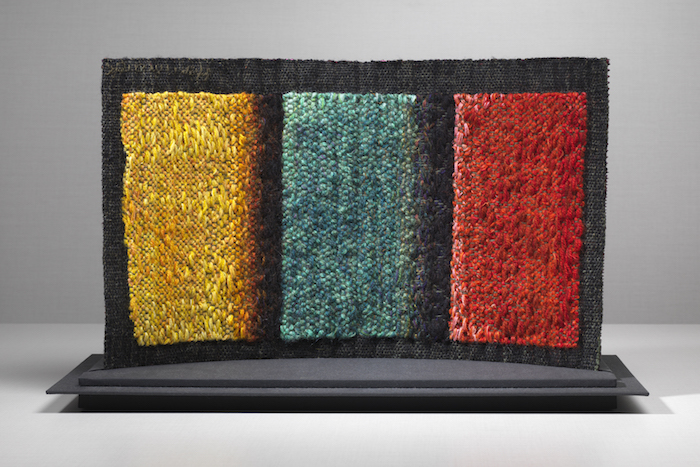MEDIA CONTACTS:
Brett Zongker: bzongker gwu [dot] edu (bzongker[at]gwu[dot]edu), 202-994-6466
gwu [dot] edu (bzongker[at]gwu[dot]edu), 202-994-6466
Maralee Csellar: csellar gwu [dot] edu (csellar[at]gwu[dot]edu), 202-994-7564
gwu [dot] edu (csellar[at]gwu[dot]edu), 202-994-7564
WASHINGTON (Sept. 28, 2017)—Contemporary fiber artworks commissioned through a challenge to artists by Los Angeles collector Lloyd Cotsen will be showcased in “The Box Project: Uncommon Threads” at the George Washington University Museum and The Textile Museum. The exhibition will be on view Sept. 30 through January 29, 2018.
“The Box Project” features pieces by 36 acclaimed international artists, including Richard Tuttle, Cynthia Schira, Gerhardt Knodel, Helena Hernmarck, James Bassler and Gyöngy Laky, among others. The exhibition showcases a diverse collection of works that reflect the artists’ creative and ingenious use of fiber to create new works of art.
Mr. Cotsen, the former CEO of Neutrogena, was a passionate art collector and philanthropist. The project originated in the early 2000s when Mr. Cotsen and his then curator, Mary Hunt Kahlenberg, who died in 2011, invited the artists to respond to a challenge. Would the artists – most of whom generally create two-dimensional fiber works – attempt a three-dimensional piece that could fit into a small, shallow box?
Each artist interpreted the challenge in his or her own way, with widely divergent results. Most of the pieces in the show are presented in their boxes that measure 23 inches by 14 inches or 14 inches by 14 inches. Additional examples that are more typical of the artists’ work will also be featured to provide context on how they were challenged by the project.
“‘The Box Project’ encouraged artists to think outside the box by forcing them to work within it,” said Camille Ann Brewer, curator of contemporary art at the George Washington University Museum and The Textile Museum. “The variety of solutions that resulted and the range of materials and techniques used by the artists demonstrate the project’s success.”
Many of the artists push the boundaries of fiber. The creations use plastic tubing, copper wire, paper, wood, zippers, buttons, beads, magnets, reflective tape, sponges and spools of thread to great effect. The themes and appearances of the artworks themselves are as diverse as the materials they employ.
For example, Virginia Davis’ submission conjures the vastness of the night sky, and Ai Kijima’s quilted collage employs the pop culture imagery of children’s cartoons. Mr. Knodel and Mr. Bassler both invoke game boards in unique ways. Some works fit neatly in their boxes while others, such as Aune Taamal’s delicate weaving can be stored in their boxes but overflow their confines when unfolded for display.
The small scale of the works in “The Box Project” offers viewers an intimate experience with the commissioned art. Other elements on display include borrowed works for comparison, video interviews, material samples and concept sketches to provide background on the artists and their processes.
“The Box Project” was organized by the Cotsen Foundation for Academic Research with the Racine Art Museum and curated by Lyssa C. Stapleton and Bruce W. Pepich. The George Washington University Museum and The Textile Museum will host public programs throughout the duration of the exhibition, including programs presented by Ms. Hernmarck, Mr. Tuttle, and Kyoko Nitta, and a free family day Oct. 21 with demonstrations by Ms. Kijima, hands-on art activities and performances.
The Genesis of “The Box Project”
Mr. Cotsen, a former member of The Textile Museum’s board who died in May, built and dispersed several world-class collections in collaboration with his textile curator and friend Ms. Kahlenberg and current curator Ms. Stapleton – including the most comprehensive collection of Japanese bamboo baskets in the world, now at the Asian Art Museum in San Francisco.
In the mid-1990s, the team began to assemble a new collection of textile fragments from every era and region of the world. Mr. Cotsen determined that all the fragments be smaller than 23 by 14 inches and be kept in beautiful, handmade storage boxes. These are the same boxes that are integral to “The Box Project.” By setting these physical parameters, Mr. Cotsen came to appreciate the power of limits.
“When I place restrictions on my collecting, the results are more dynamic,” he said. Understanding that boundaries can encourage innovation, he was curious to see how artists might respond to a commission with specific limitations. Thus was born “The Box Project.”
The artists featured in this exhibition are Masae Bamba, James Bassler, Mary Bero, Zane Berzina, N. Dash, Virginia Davis, Carson Fox, Shigeki Fukumoto, John Garrett, Ana Lisa Hedstrom, Helena Hernmarck, Agneta Hobin, Pat Hodson, Kiyomi Iwata, Gere Kavanaugh, Ai Kijima, Hideaki Kizaki, Lewis Knauss, Nancy Koenigsberg, Gerhardt Knodel, Naomi Kobayashi, Gyöngy Laky, Paola Moreno, Jun Mitsuhashi, Kyoko Nitta, Hisako Sekijima, Barbara Murak, Cynthia Schira, Heidrun Schimmel, Carol Shinn, Sherri Smith, Hadi Tabatabai, Koji Takaki, Aune Taamal, Richard Tuttle and Peter Weber.
Current Exhibitions
“Scraps: Fashion, Textiles and Creative Reuse” explores the work of three innovative designers focused on improving sustainability and reducing waste in the fashion design process. Textile and apparel manufacturing is one of the most polluting industries in the world. The featured designers use scraps and cast-offs to create desirable products. The exhibition is on view through Jan. 7, 2018.
In the exhibition “Foundations for a Nation: Architectural Images from the Albert H. Small Washingtoniana Collection,” historical images reveal how public competitions, presidential preferences and unanticipated historical events shaped two of Washington’s most iconic landmarks: the U.S. Capitol and White House. The exhibition is open through Oct. 16.
“A Collector’s Vision: Selections from the Albert H. Small Washingtoniana Collection” displays maps, letters, prints, and artifacts from the museum’s Albert H. Small Washingtoniana Collection, including recent acquisitions and rare treasures. Donated to GW in 2011, Mr. Small’s unrivaled collection traces the founding and evolution of our nation’s capital.
Visit the museum’s website for information on programs: www.museum.gwu.edu.
-GW-


